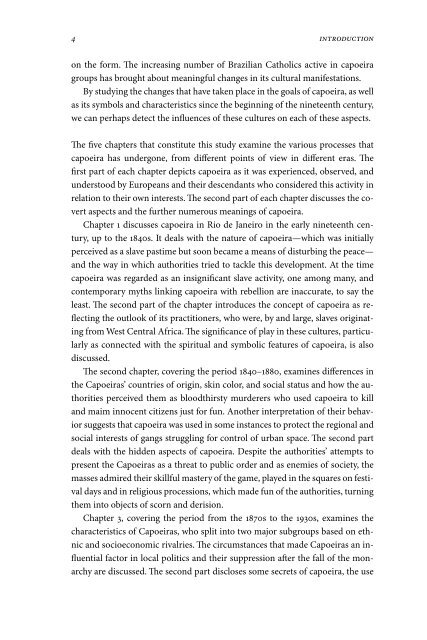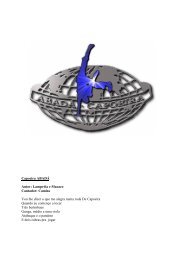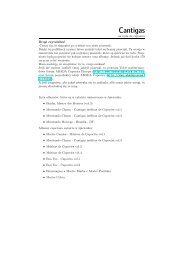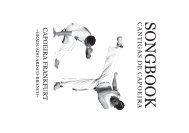A Collision of Cultures in the Brazilian Battle Dance - Capoeira Music
A Collision of Cultures in the Brazilian Battle Dance - Capoeira Music
A Collision of Cultures in the Brazilian Battle Dance - Capoeira Music
You also want an ePaper? Increase the reach of your titles
YUMPU automatically turns print PDFs into web optimized ePapers that Google loves.
IntroductIon<br />
on <strong>the</strong> form. The <strong>in</strong>creas<strong>in</strong>g number <strong>of</strong> <strong>Brazilian</strong> Catholics active <strong>in</strong> capoeira<br />
groups has brought about mean<strong>in</strong>gful changes <strong>in</strong> its cultural manifestations.<br />
By study<strong>in</strong>g <strong>the</strong> changes that have taken place <strong>in</strong> <strong>the</strong> goals <strong>of</strong> capoeira, as well<br />
as its symbols and characteristics s<strong>in</strong>ce <strong>the</strong> beg<strong>in</strong>n<strong>in</strong>g <strong>of</strong> <strong>the</strong> n<strong>in</strong>eteenth century,<br />
we can perhaps detect <strong>the</strong> <strong>in</strong>fluences <strong>of</strong> <strong>the</strong>se cultures on each <strong>of</strong> <strong>the</strong>se aspects.<br />
The five chapters that constitute this study exam<strong>in</strong>e <strong>the</strong> various processes that<br />
capoeira has undergone, from different po<strong>in</strong>ts <strong>of</strong> view <strong>in</strong> different eras. The<br />
first part <strong>of</strong> each chapter depicts capoeira as it was experienced, observed, and<br />
understood by europeans and <strong>the</strong>ir descendants who considered this activity <strong>in</strong><br />
relation to <strong>the</strong>ir own <strong>in</strong>terests. The second part <strong>of</strong> each chapter discusses <strong>the</strong> covert<br />
aspects and <strong>the</strong> fur<strong>the</strong>r numerous mean<strong>in</strong>gs <strong>of</strong> capoeira.<br />
Chapter 1 discusses capoeira <strong>in</strong> rio de Janeiro <strong>in</strong> <strong>the</strong> early n<strong>in</strong>eteenth century,<br />
up to <strong>the</strong> 1840s. it deals with <strong>the</strong> nature <strong>of</strong> capoeira—which was <strong>in</strong>itially<br />
perceived as a slave pastime but soon became a means <strong>of</strong> disturb<strong>in</strong>g <strong>the</strong> peace—<br />
and <strong>the</strong> way <strong>in</strong> which authorities tried to tackle this development. at <strong>the</strong> time<br />
capoeira was regarded as an <strong>in</strong>significant slave activity, one among many, and<br />
contemporary myths l<strong>in</strong>k<strong>in</strong>g capoeira with rebellion are <strong>in</strong>accurate, to say <strong>the</strong><br />
least. The second part <strong>of</strong> <strong>the</strong> chapter <strong>in</strong>troduces <strong>the</strong> concept <strong>of</strong> capoeira as reflect<strong>in</strong>g<br />
<strong>the</strong> outlook <strong>of</strong> its practitioners, who were, by and large, slaves orig<strong>in</strong>at<strong>in</strong>g<br />
from West Central africa. The significance <strong>of</strong> play <strong>in</strong> <strong>the</strong>se cultures, particularly<br />
as connected with <strong>the</strong> spiritual and symbolic features <strong>of</strong> capoeira, is also<br />
discussed.<br />
The second chapter, cover<strong>in</strong>g <strong>the</strong> period 1840–1880, exam<strong>in</strong>es differences <strong>in</strong><br />
<strong>the</strong> <strong>Capoeira</strong>s’ countries <strong>of</strong> orig<strong>in</strong>, sk<strong>in</strong> color, and social status and how <strong>the</strong> authorities<br />
perceived <strong>the</strong>m as bloodthirsty murderers who used capoeira to kill<br />
and maim <strong>in</strong>nocent citizens just for fun. ano<strong>the</strong>r <strong>in</strong>terpretation <strong>of</strong> <strong>the</strong>ir behavior<br />
suggests that capoeira was used <strong>in</strong> some <strong>in</strong>stances to protect <strong>the</strong> regional and<br />
social <strong>in</strong>terests <strong>of</strong> gangs struggl<strong>in</strong>g for control <strong>of</strong> urban space. The second part<br />
deals with <strong>the</strong> hidden aspects <strong>of</strong> capoeira. despite <strong>the</strong> authorities’ attempts to<br />
present <strong>the</strong> <strong>Capoeira</strong>s as a threat to public order and as enemies <strong>of</strong> society, <strong>the</strong><br />
masses admired <strong>the</strong>ir skillful mastery <strong>of</strong> <strong>the</strong> game, played <strong>in</strong> <strong>the</strong> squares on festival<br />
days and <strong>in</strong> religious processions, which made fun <strong>of</strong> <strong>the</strong> authorities, turn<strong>in</strong>g<br />
<strong>the</strong>m <strong>in</strong>to objects <strong>of</strong> scorn and derision.<br />
Chapter 3, cover<strong>in</strong>g <strong>the</strong> period from <strong>the</strong> 1870s to <strong>the</strong> 1930s, exam<strong>in</strong>es <strong>the</strong><br />
characteristics <strong>of</strong> <strong>Capoeira</strong>s, who split <strong>in</strong>to two major subgroups based on ethnic<br />
and socioeconomic rivalries. The circumstances that made <strong>Capoeira</strong>s an <strong>in</strong>fluential<br />
factor <strong>in</strong> local politics and <strong>the</strong>ir suppression after <strong>the</strong> fall <strong>of</strong> <strong>the</strong> monarchy<br />
are discussed. The second part discloses some secrets <strong>of</strong> capoeira, <strong>the</strong> use






